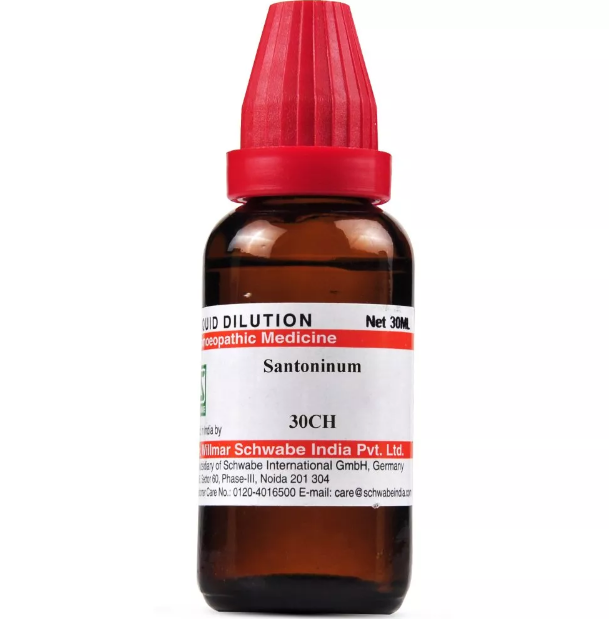SANTONINUM 6C, 12C, 30C, 200C, 1M, 10M USES AND SYMPTOMS
 SANTONINUM
SANTONINUM
(Santonin)
Santin.
Is the active compound derived from Santonica, the unopened flower buds of Artemisia maritima-Cina. It primarily affects the eyes and urinary system. It is highly effective in treating worm infections, particularly Ascaris lumbricoides and threadworms, though not tapeworms. It also helps with gastrointestinal irritation, nose itching, restless sleep, and muscle twitching. Other uses include treating nocturnal cough in children, chronic cystitis, and laryngeal crises or sharp pains from tabes.
Head: Occipital headaches with visual hallucinations.
Eyes: Sudden vision dimness (amblyopia, cataracts), color blindness, yellow vision (xanthopsia), and strabismus caused by worms. Dark circles around the eyes.
Nose: Itching and nose-boring behavior.
Mouth: Bad breath, altered appetite, thirst, red tongue, teeth grinding, nausea (improves after eating), choking sensation.
Urinary: Greenish urine in acidic conditions, reddish-purple in alkaline. Incontinence, painful urination, bedwetting, a full bladder sensation, nephritis.
Relationship: Compare with Cina, Teucrium, Naphtin, Natrum phosphoricum, Spigelia.
Dose: Use the second to third trituration. Lower doses can be toxic. Avoid giving to children with fever or constipation.
SYMPTOMS OF SANTONINUM
Head:
Occipital headaches (back of the head)
Chromatic (color) hallucinations
Eyes:
Sudden dimness of vision (amblyopia, cataracts)
Color blindness
Xanthopsia (yellow-tinted vision)
Strabismus (crossed eyes) caused by worms
Dark rings around the eyes
Nose:
Itching sensation on the nose
Boring into the nostrils
Mouth:
Halitosis (bad breath)
Altered appetite
Thirst
Deep red tongue
Teeth grinding
Nausea (relieved after eating)
Choking sensation
Urinary:
Greenish urine if acidic, reddish-purple urine if alkaline
Incontinence
Dysuria (painful urination)
Enuresis (bedwetting)
Fullness sensation in the bladder
Nephritis (kidney inflammation)
selection of the potency
Individualization:
- Homeopathy is based on the principle of treating the individual, not just the disease. The unique symptoms and characteristics of the person are crucial in determining the most suitable potency.
Intensity of Symptoms:
- The intensity of the symptoms guides the choice of potency. If the symptoms are intense and acute, a lower potency (e.g., 6C, 30C) might be considered. For chronic conditions with less intensity, higher potencies (e.g., 200C, 1M) may be appropriate.
Sensitivity of the Patient:
- Some individuals are more sensitive to homeopathic remedies, while others may require higher potencies. The practitioner considers the patient’s sensitivity when selecting the potency.
Acute vs. Chronic Conditions:
- Lower potencies are often used for acute conditions, while higher potencies may be considered for chronic or long-standing issues.
Previous Response to Potencies:
- The patient’s response to previous homeopathic treatments helps guide the choice of potency. If a particular potency has been effective in the past, it may be repeated or adjusted as needed.
Vital Force and Susceptibility:
- Homeopathy views illness as a disturbance in the vital force. The practitioner assesses the patient’s overall vitality and susceptibility to determine the appropriate potency.
Aggravation or Amelioration:
- The direction of the symptom response (aggravation or amelioration) after taking a remedy can influence the choice of potency.
Miasmatic Considerations:
- In classical homeopathy, the concept of miasms (inherited disease tendencies) is considered. The practitioner take this into account when selecting the potency.
Practitioner Experience:
- The experience and preference of the homeopathic practitioner play a role. Some practitioners may have success with certain potencies based on their clinical experience.
SAFETY INFORMATION
- Do not exceed the recommended dose by physician
- Keep out of the reach of children
- Store in a cool dry place away from direct sunlight
- Maintain half an hour gap between food/drink/any other medicines and homoeopathic medicine
- Avoid any strong smell in the mouth while taking medicine e.g. camphor, garlic, onion, coffee, hing
Medicine images use for reference only selection of homeopathic medicine depends on the individual’s specific symptoms and overall constitution. Moreover, homeopathy is a holistic system of medicine that treats the individual as a whole. In addition to addressing the physical symptoms, it takes into account the emotional and mental state of the person. Consequently, it’s crucial to consult with a qualified homeopathic practitioner for personalized treatment.
The information provided on this website is intended solely for educational purposes. Always seek the advice of your physician or other qualified health provider.
